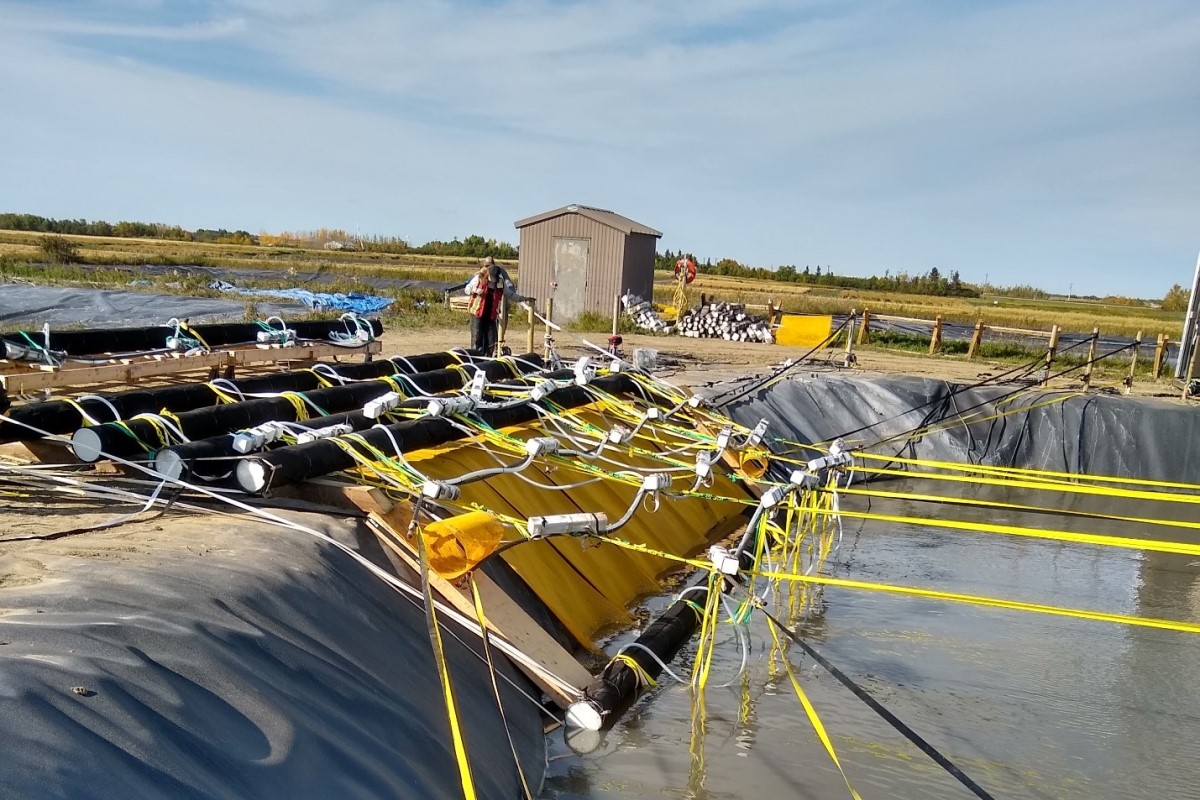Across the Alberta oil sands, more than 250 square kilometres of tailings ponds hold a hazardous slurry of water, residual bitumen and fine clay particles — the byproduct created from the bitumen extraction process. Before those ponds can be reclaimed as forests or wetlands, the solids content must be boosted to at least 60 per cent. The question is how?
ElectroKinetic Solutions (EKS) offers an answer. In Vegreville, Alberta, 100 kilometres east of Edmonton, they’re conducting a field trial of an innovative dewatering technology. They’ve installed electrodes across a converted sewage lagoon, now filled with 1,700 cubic metres of oil sands tailings. By sending a current through the slurry, clay particles are drawn to the anode via electrophoresis, while electro-osmosis pulls water molecules to the cathode — a dewatering technology they call the EKS-DT process.
And the numbers are impressive. “We can achieve 60 per cent solids consistently in the lab,” says Ed Hanna, the company’s vice-president of research and technology development. “So far, we’re pleased with the dewatering results for the field test. The results are promising.”
Bringing a breakthrough to market
EKS couldn’t have reached this point without Advancing Water Technologies (AWT) funding from the Ontario Water Consortium (OWC) in 2016. At that point, a major oil company had expressed interest but wanted more data on the EKS-DT process. It was a critical moment for the young company.
“If we hadn’t had AWT funding, I don’t think EKS would have survived,” Hanna says candidly.
AWT support enabled EKS to team up with Western University electrokinetics expert Dr. Julie Shang and to conduct testing at OWC’s London wastewater facility. Over the course of two years, they showed their dewatering technology could be successfully scaled up beyond the lab scale.
Now, with nearly $2 million in funding from Natural Resources Canada and support from Alberta Innovates, Sustainable Development Technology Canada and Canadian Natural Resources Ltd., EKS is conducting a large-scale field test at Vegreville.
Going bigger creates three main challenges. One is energy use. As you move electrodes further apart, it takes more electricity to generate a current between them, so EKS is looking for ways to make the process as energy efficient as possible.
Second, the “sacrificial” metal anodes shed ions during the electrokinetic process. The company has conducted studies to calculate exactly how much metal to install initially to ensure there’s enough for the system to keep running until the dewatering targets are met. Finally, EKS is developing an accurate forecasting model to optimise the design of the electrode arrays and to forecast the dewatering rate.
Based on the progress they’ve made since launching the field test last fall, Hanna expects to be ready to set up a commercial pilot early next year and to go to market in 2022.
Wastewater treatment, soil remediation and more
Tailing pond dewatering isn’t the only application for EKS technology. The company’s wastewater treatment process (EKS-WT) promises to radically improve the efficiency of sewage treatment.
Current sewage treatment requires lots of energy and lots of space to remove organic solids from the incoming wastewater. Typically, it involves a three-stage approach of physical settling, aerobic digestion and tertiary treatment. A byproduct of this process is sludge that is about eight per cent solids, essentially a fluid with some suspended fine particles. EKS figured they could use electrokinetics to treat sewage more efficiently — and also create sludge with a much higher solids content. This reduces the total volume and increases the energy content significantly.
But that’s not all. Running a current through water electrolyzes it, creating oxygen that is used to break down residual biological and chemical contaminants. Meanwhile, using sacrificial anodes made of either iron or aluminum, metal ions are released that bind to phosphate in the sewage, eliminating the need for tertiary treatment.
The concept was good. But would it work? Through a second AWT project, EKS teamed up with University of Guelph engineering professor Bassim Abbassi to run pilots at the OWC’s Guelph facility and prove their system was viable. “AWT funding for WT allowed us to do critical primary research essential for advancing that technology,” Hanna says.
EKS has also developed electrokinetic-based soil treatment technology to reclaim contaminated sites, particularly in the oil and gas sector. Most recently, the company began working on a fourth application for mine tailings in arid climates. “In those environments, water is gold,” says Hanna. “So we’ve developed a process to be able to recycle rapidly water out of tailings back into the mineral extraction process.”
To move all these projects forward, EKS has expanded its team. They’ve hired an electric-chemical engineer and a post-doc chemical engineer to work on their tailings technology in Alberta and taken on a recent environmental engineering graduate to run the lab in Guelph.
Using resources more efficiently
According to Hanna, supporting innovation is a smart investment. “We can’t be continually just extracting resources as in the past and also having an expanding population. We cannot sustain that,” he says. “But what we can do, with innovation and technology development, is use the resources that we have more efficiently reducing the human footprint on the environment.”
And that’s exactly what EKS promises to do.


